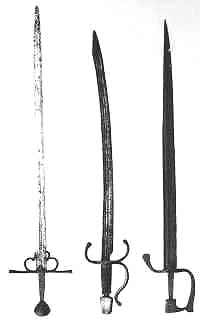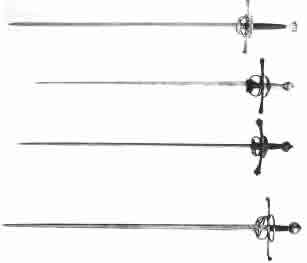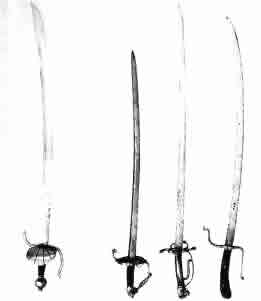ARMA
Director John Clements answers Youth email on swords and swordsmanship:
 Question: Why are there so many different kinds of sword, which one is better?
Question: Why are there so many different kinds of sword, which one is better?
To answer this question it must first be
understood that offense and defense are qualities that are in
competition in a sword. Historically speaking, a sword was a product of
the given technology and skill of the maker who created it. Some swords
might be stronger or sharper than others, and some better made than
others. Any design would be one that a fighting man needed to meet the
kind of challenges he expected to face in combat. These conditions
varied around the world at different times. This resulted in different
sword designs. But every type of sword was crafted as a solution to
similar problems of self-defense. Every sword had two essential
functions: to guard (or parry) and to strike (by cut, thrust, or both).
Since ancient times both cutting and thrusting
swords were known to be effective in single-combat as well as the
battlefield of war. Any sword would be expected to face other weapons
as well as armors. Armor could be of either hard or soft material, each
with differing degrees of resistance and maneuverability. All manner of
swords intended for cutting or for thrusting or for both were
constantly developed and tested to meet these challenges. Their blades
might be wide or narrow, thick or thin, straight or curved, single or
double-edged, tapered or un-tapered, sharply edged or not, and for one
or two hands.
 But
any sword design is a compromise between certain contradictory traits:
a sword has to be hard to hold a sharp edge or sharp point but
resilient so as not to bend or break under stress. It must guard or
ward against other weapons as well as successfully damage targets
(armored or unarmored). No one sword achieves all the best effects of
every other kind. Some might be better used on foot than on horseback,
some better at fighting with a shield or second weapon, some better for
single combat or for the battlefield, and some superior at penetrating
soft armors or hard armor or even at fighting entirely unarmored.
That’s why in various cultures throughout history specialized varieties
of swords came to exist through generations of trial and error
experiment.
But
any sword design is a compromise between certain contradictory traits:
a sword has to be hard to hold a sharp edge or sharp point but
resilient so as not to bend or break under stress. It must guard or
ward against other weapons as well as successfully damage targets
(armored or unarmored). No one sword achieves all the best effects of
every other kind. Some might be better used on foot than on horseback,
some better at fighting with a shield or second weapon, some better for
single combat or for the battlefield, and some superior at penetrating
soft armors or hard armor or even at fighting entirely unarmored.
That’s why in various cultures throughout history specialized varieties
of swords came to exist through generations of trial and error
experiment.
Over time
different swordmakers experimenting and working in different places
came up with many different ways of making swords with assorted
characteristics that achieved the fighting needs of swordsmen in one
way or another. This is why sword blades will have different cross-sectional
shapes and edge-geometries that make them either stiffer or more
resilient and thus better at cutting or at thrusting.
Not all sword types perform in the same manner. Sword designs
are actually specialized tools. Depending upon their cross-sectional
geometry, dimensions of length and width, and edge and point
configurations, some types will do one thing very well but not another.
The historical challenges of different battlefield and self-defense
needs resulted in a wide range of long bladed weapon designs (and
methods for effectively employing them). Some may have been intended
more for cutting or slashing at either hard or soft targets, thrusting
only at hard or soft targets, or a compromise somewhere in between. The
characteristic qualities that permit one action will hinder the other.
This gives different sword types different strengths and weaknesses
depending upon how and why they were expected to be used. What is important to understand is how with the eventual development
in Europe of slender single-handed thrusting swords, idea for unarmored civilian
dueling, is that they were not simply new “thinner” versions of earlier
wider swords suited to battlefield fighting. Rather, differences in blade geometry—in thickness as
well as width along its length—is an attribute of all types of sword.
This variation is precisely how various sword types are stiffer or more
resilient than another, may feel heavier or lighter in their hilt or
blade, and can be more adept at either thrusting or cutting at
different materials.
 Each
sword design differs as to what it can do best within whatever kind of
fighting conditions it was created to perform under. Each has its
specialization, even if it is generalized.
The effectiveness of any sword strike depends on the kind of target
area hit in regard to the form or shape of the blade and severity of
the blow. Both cutting and thrusting techniques can each be more
effective or less effective depending upon the tactical context.
Writing on thrusting in his fighting treatise of the 1480s, the Italian
fencing master Filippo Vadi for example noted how, “Against one man the
thrust is good, but against many it does not work,” adding that both
books and actions confirmed this.
Each
sword design differs as to what it can do best within whatever kind of
fighting conditions it was created to perform under. Each has its
specialization, even if it is generalized.
The effectiveness of any sword strike depends on the kind of target
area hit in regard to the form or shape of the blade and severity of
the blow. Both cutting and thrusting techniques can each be more
effective or less effective depending upon the tactical context.
Writing on thrusting in his fighting treatise of the 1480s, the Italian
fencing master Filippo Vadi for example noted how, “Against one man the
thrust is good, but against many it does not work,” adding that both
books and actions confirmed this.
The variety of swords in history is immense. Different
sword types were rarely identified by their own distinct labels so
modern arms historians have classified or categorized them into
families of assorted kinds. Cutting and thrusting types could each be
decisive in sword combat but combined together they could be even more
so. Thus, the study of sword types and their characteristics, or spathology,
is an ongoing process that recognizes no one sword as absolutely
superior to any other. All of this is why there is no such thing as the
“perfect sword.”
Kids, Got Questions?
Send in your questions about swords or historical fencing to us.
We’ll do our best to answer any polite well-written question about Medieval and Renaissance close-combat
or provide you with references to learn more.

